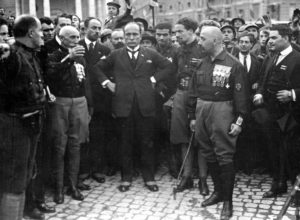Jabari Asim: Invisible Men
Despite their courage and achievements in the Revolutionary War, blacks usually went unnoticed. Now, finally, one such man receives some recognition.Despite their courage and achievements in the Revolutionary War, blacks usually went unnoticed. Now, finally, one such man receives some recognition.
WASHINGTON — “I am an invisible man,” Ralph Ellison memorably wrote. “I am a man of substance, of flesh and bone, fiber and liquids — and I might even be said to possess a mind. I am invisible, understand, simply because people refuse to see me.”
I thought of Ellison’s introduction to his classic novel while reading the affirming yet oddly familiar saga of Oscar Marion. He was a slave owned by Gen. Francis Marion, a hero of the Revolutionary War known as the “Swamp Fox.” Both men are immortalized in a painting that has decorated a wall in the U.S. Capitol since 1899.
“General Marion Inviting a British Officer to Share His Meal” by John Blake White portrays the general exchanging courtesies with his red-coated counterpart. The “Swamp Fox” is shown in a clearing amid his ragtag band of rebels, extending a hand in hospitality while a black man kneels by the fire. That man, we now know, was named Oscar.
As reported in The Washington Post, Oscar’s identity was uncovered by Tina C. Jones, a distant relative whose efforts led to a Dec. 15 ceremony at the Capitol. In a building constructed mostly by slaves, Oscar Marion was honored with a presidential proclamation recognizing his “devoted and selfless consecration to the service of our country in the Armed Forces of the United States.”
Many books have been written about Francis Marion. Jones told the Post that most of them describe Oscar as “the faithful Negro servant.” Her research showed that Oscar Marion accompanied the general for seven years and fought in the militia as well. His contribution, like his name, was long lost to memory.
The other estimated 5,000 black men who served in the Revolutionary forces suffered similar destinies, seldom recalled or acknowledged. We know about a few, such as William Lee, who accompanied George Washington so steadfastly in battle that he was called “the black shadow.” And we’ve heard of Peter Salem, whose heroism at Bunker Hill was commemorated in a painting by John Trumbull. At Bunker Hill, Salem shot and killed the leader of the British charge. American officers saluted Salem for his courage and eventually introduced him to Washington. For a while, Salem endured a fate even more inglorious than anonymity: Subsequent engravings of Trumbull’s painting often left the black patriot out entirely.
But even when these men are actually portrayed, as in White’s painting, they are seldom noticed. It’s almost as if, to echo Ellison’s telling phrase, succeeding generations of Americans have refused to see them.
Experts believe White created the painting between 1815 and 1825, a period when the portrayal of African-Americans began to decline almost completely into caricature. Oscar Marion, by comparison, received a very dignified treatment. Although his facial features were not deliberately exaggerated — as was typical of the time — his kneeling posture makes his lowly stature clear.
In that regard, White’s painting is part of a well-established tradition: He is shown kneeling while everyone else is shown standing. “Henry Darnall III as a Child” (circa 1710) by Justus Engelhardt Kuhn is believed to be one of the earliest depictions of a black person in an American painting. In it, an unidentified black youth kneels beside his young master, a lushly garbed white boy who looks to be of primary school age. Similarly, “Charles Calvert and Colored Slave,” completed by Maryland-born John Hesselius in 1761, features a pampered young aristocrat. His slave is prominently featured too, once again kneeling obediently and gazing upward at his master.
We know that Peter Salem died in a Massachusetts poorhouse in 1816. We know that William Lee had to wait until 16 years after the war for his freedom. Washington’s will provided for his freedom, food and clothing, and a yearly allowance of $30 for his “faithful services during the Revolutionary War.” We know little of Oscar Marion’s life other than what Jones has unearthed, and we certainly don’t know what he was thinking on days like the one preserved in White’s painting.
But I suspect Ellison’s words probably aren’t far off: “When they approach me they see only my surroundings, themselves, or figments of their imagination –indeed, everything and anything except me.”
Jabari Asim’s e-mail address is [email protected].
© 2006, Washington Post Writers Group
Your support is crucial…With an uncertain future and a new administration casting doubt on press freedoms, the danger is clear: The truth is at risk.
Now is the time to give. Your tax-deductible support allows us to dig deeper, delivering fearless investigative reporting and analysis that exposes what’s really happening — without compromise.
Stand with our courageous journalists. Donate today to protect a free press, uphold democracy and unearth untold stories.









You need to be a supporter to comment.
There are currently no responses to this article.
Be the first to respond.